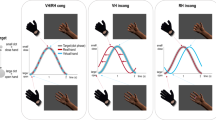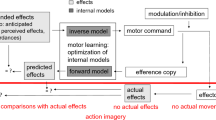Abstract
According to active inference (which subsumes the framework of predictive processing), action is enabled by a top-down modulation of sensory signals. Computational models of this mechanism complement ideomotor theories of action representation. Such theories postulate common neural representations for action and perception, without specifying how action is enabled by such representations. In active inference, motor commands are replaced by proprioceptive predictions. In order to initiate action through such predictions, sensory prediction errors have to be attenuated. This paper argues that such top-down modulation involves systematic (but paradoxically beneficial) misrepresentations. More specifically, the paper first argues for the following conditional claim. If active inference provides an accurate computational description of how action is enabled in the brain, then action is enabled by systematic misrepresentations. Furthermore, it is argued that an inference to the best explanation provides reason for believing the antecedent is true: Firstly, active inference provides a crucial extension to ideomotor theories. Secondly, active inference explains otherwise puzzling phenomena related to sensory attenuation, e.g. in force-matching or self-tickling paradigms. Taken together, these reasons support the claim that action is indeed enabled by systematic misrepresentations. The claim casts doubt on the assumption that representations are systematically beneficial to the extent that they are true: if the argument in this paper is sound, systematically beneficial misrepresentations may lie at the heart of our neural architecture.

Similar content being viewed by others
Notes
Positive illusions are false beliefs that depict states of affairs as overly positive (in some cases, this may systematically promote well-being and mental health, cf. Taylor 1989). A particular example is the optimism bias (also called unrealistic optimism, cf. Weinstein 1980), which refers to overly positive expectations about future events. As such, an optimism bias need not be beneficial for the agent, but at least a moderate optimism bias seems to be (cf. Sharot 2011, p. R944).
The earliest pre-cursor of ideomotor theories seems to be the view put forward in Herbart (1825, pp. 464 f.).
Technically, both active inference and predictive processing are corollaries of Karl Friston’s free-energy principle (cf. Friston 2010). The free-energy principle provides a general formulation of self-organization where, in the context of the brain, prediction errors can be regarded as a proxy for free energy.
Perceptual and active inference are sometimes described as distinct, but complementary processes. However, “active inference” is also used as a generic term for the computational processes underpinning both action and perception (cf. Friston et al. 2012b, p. 539). This is the primary sense in which the term is used in this paper.
Note here a distinction between ascending and descending prediction errors. The ascending prediction errors from the spinal cord are those that revise estimates in the central nervous system, while descending prediction errors are sent to the periphery to activate classical motor reflexes. Attenuation of ascending prediction errors enables movement, while attenuation of both ascending and descending prediction errors is necessary to prohibit echopraxia, mimicry, or mirror movements during action observation. Thanks to an anonymous referee for pointing this out.
From the point of view of Karl Friston’s free-energy principle, the relevance of attenuating sensory precision is even more obvious. Active inference is here regarded as a means to minimize free energy by changing sensory samples. Under quite general assumptions, minimizing free energy entails minimizing prediction error. The reduction of prediction errors in active inference necessarily depends upon resampling the world and, by implication, the attenuation of sensory precision. This means, in the long-term, the misrepresentation (attenuation) of sensory precision reduces prediction errors and is quintessentially beneficial for any sentient agent, because it enables active inference and thereby enables the agent to stay within viable regions of its state space. This is the premise of the free-energy principle, in which prediction errors can be regarded as free energy—and both are proxies for negative (Bayesian) model evidence. I am grateful to an anonymous referee for emphasizing this point.
As an anonymous reviewer remarked, if one identifies attention with predictions of precisions (not with the process of optimizing these predictions), and if the precision predicted does not correspond to the actual signal-to-noise ratio of sensory inputs (as in sensory attenuation or spatial attention) then, by definition, attention can be called a beneficial misrepresentation.
References
Adams, R. A., Shipp, S., & Friston, K. J. (2013). Predictions not commands: Active inference in the motor system. Brain Structure and Function, 218(3), 611–643. doi:10.1007/s00429-012-0475-5.
Bäß, P., Jacobsen, T., & Schröger, E. (2008). Suppression of the auditory N1 event-related potential component with unpredictable self-initiated tones: Evidence for internal forward models with dynamic stimulation. International Journal of Psychophysiology, 70(2), 137–143.
Blakemore, S.-J., Frith, C. D., & Wolpert, D. M. (1999). Spatio-temporal prediction modulates the perception of self-produced stimuli. Journal of Cognitive Neuroscience, 11(5), 551–559. doi:10.1162/089892999563607.
Botvinick, M., & Cohen, J. (1998). Rubber hands ‘feel’ touch that eyes see. Nature, 391(6669), 756.
Brown, H., Adams, R., Parees, I., Edwards, M., & Friston, K. (2013). Active inference, sensory attenuation and illusions. Cognitive Processing, 14(4), 411–427. doi:10.1007/s10339-013-0571-3.
Chapman, C., Bushnell, M., Miron, D., Duncan, G., & Lund, J. (1987). Sensory perception during movement in man. Experimental Brain Research, 68(3), 516–524.
Clark, A. (2013). Whatever next? Predictive brains, situated agents, and the future of cognitive science. Behavioral and Brain Sciences, 36(3), 181–204. doi:10.1017/S0140525X12000477.
Clark, A. (2015). Radical predictive processing. The Southern Journal of Philosophy, 53, 3–27. doi:10.1111/sjp.12120.
Clark, A. (2016). Surfing uncertainty: Prediction, action, and the embodied mind. New York: Oxford University Press.
Feldman, H., & Friston, K. J. (2010). Attention, uncertainty, and free-energy. Frontiers in Human Neuroscience. doi:10.3389/fnhum.2010.00215.
Friston, K. (2010). The free-energy principle: A unified brain theory? Nature Reviews Neuroscience, 11(2), 127–138. doi:10.1038/nrn2787.
Friston, K. (2011). What is optimal about motor control? Neuron, 72(3), 488–498. doi:10.1016/j.neuron.2011.10.018.
Friston, K., Adams, R., Perrinet, L., & Breakspear, M. (2012a). Perceptions as hypotheses: Saccades as experiments. Frontiers in Psychology. doi:10.3389/fpsyg.2012.00151.
Friston, K., Mattout, J., & Kilner, J. (2011). Action understanding and active inference. Biological Cybernetics, 104(1–2), 137–160. doi:10.1007/s00422-011-0424-z.
Friston, K., Samothrakis, S., & Montague, R. (2012b). Active inference and agency: Optimal control without cost functions. Biological Cybernetics, 106(8), 523–541. doi:10.1007/s00422-012-0512-8.
Friston, K. J., & Stephan, K. E. (2007). Free-energy and the brain. Synthese, 159(3), 417–458. doi:10.1007/s11229-007-9237-y.
Gigerenzer, G., Todd, P. M., & the ABC Research Group. (1999). Simple heuristics that make us smart. New York: Oxford University Press.
Herbart, J. F. (1825). Psychologie als Wissenschaft neu gegründet auf Erfahrung, Metaphysik und Mathematik. Zweiter, analytischer Teil. Königsberg: Unzer.
Hohwy, J. (2013). The predictive mind. Oxford: Oxford University Press.
Hommel, B. (2015). The theory of event coding (TEC) as embodied-cognition framework. Frontiers in Psychology. doi:10.3389/fpsyg.2015.01318.
Hommel, B., Müsseler, J., Aschersleben, G., & Prinz, W. (2001). The theory of event coding (TEC): A framework for perception and action planning. Behavioral and Brain Sciences, 24, 849–878. doi:10.1017/S0140525X01000103.
Humberstone, I. L. (1992). Direction of fit. Mind, 101(401), 59–83.
Hurley, S. L. (1998). Vehicles, contents, conceptual structure, and externalism. Analysis, 58(1), 1–6.
James, W. (1890). The principles of psychology. New York: Henry Holt.
Lotze, R. H. (1852). Medicinische Psychologie oder Physiologie der Seele. Leipzig: Weidmann’sche Buchhandlung.
McKay, R. T., & Dennett, D. C. (2009). The evolution of misbelief. Behavioral and Brain Sciences, 32(6), 493–510. doi:10.1017/S0140525X09990975.
Mendelovici, A. (2013). Reliable misrepresentation and tracking theories of mental representation. Philosophical Studies, 165(2), 421–443. doi:10.1007/s11098-012-9966-8.
Milne, R., Aniss, A., Kay, N., & Gandevia, S. (1988). Reduction in perceived intensity of cutaneous stimuli during movement: A quantitative study. Experimental Brain Research, 70(3), 569–576.
Pickering, M. J., & Clark, A. (2014). Getting ahead: Forward models and their place in cognitive architecture. Trends in Cognitive Sciences, 18(9), 451–456. doi:10.1016/j.tics.2014.05.006.
Prinz, W. (1990). A common coding approach to perception and action. In O. Neumann & W. Prinz (Eds.), Relationships between perception and action (pp. 167–201). Berlin: Springer.
Ramsey, W. (2007). Representation reconsidered. Cambridge: Cambridge University Press.
Rushton, D., Roghwell, J., & Craggs, M. (1981). Gating of somatosensory evoked potentials during different kinds of movement in man. Brain, 104(3), 465–491.
Sharot, T. (2011). The optimism bias. Current Biology, 21(23), R941–R945. doi:10.1016/j.cub.2011.10.030.
Shergill, S. S., Bays, P. M., Frith, C. D., & Wolpert, D. M. (2003). Two eyes for an eye: The neuroscience of force escalation. Science, 301(5630), 187. doi:10.1126/science.1085327.
Shergill, S. S., Samson, G., Bays, P. M., Frith, C. D., & Wolpert, D. M. (2005). Evidence for sensory prediction deficits in schizophrenia. American Journal of Psychiatry, 162(12), 2384–2386.
Shipp, S., Adams, R. A., & Friston, K. J. (2013). Reflections on agranular architecture: Predictive coding in the motor cortex. Trends in Neurosciences, 36(12), 706–716. doi:10.1016/j.tins.2013.09.004.
Taylor, S. E. (1989). Positive illusions: Creative self-deception and the healthy mind. New York, NY: Basic Books.
Trivers, R. (2000). The elements of a scientific theory of self-deception. Annals of the New York Academy of Sciences, 907, 114–131. doi:10.1111/j.1749-6632.2000.tb06619.x.
Tversky, A., & Kahneman, D. (1974). Judgment under uncertainty: Heuristics and biases. Science, 185(4157), 1124–1131. doi:10.1126/science.185.4157.1124.
Van Doorn, G., Paton, B., Howell, J., & Hohwy, J. (2015). Attenuated self-tickle sensation even under trajectory perturbation. Consciousness and Cognition, 36, 147–153. doi:10.1016/j.concog.2015.06.016.
Voss, M., Ingram, J. N., Wolpert, D. M., & Haggard, P. (2008). Mere expectation to move causes attenuation of sensory signals. PLoS ONE, 3(8), e2866. doi:10.1371/journal.pone.0002866.
Weinstein, N. D. (1980). Unrealistic optimism about future life events. Journal of Personality and Social Psychology, 39(5), 806–820. doi:10.1037/0022-3514.39.5.806x.
Wenger, A., & Fowers, B. J. (2008). Positive illusions in parenting: Every child is above average. Journal of Applied Social Psychology, 38(3), 611–634. doi:10.1111/j.1559-1816.2007.00319.x.
Wiese, W. (2014). Jakob Hohwy: The predictive mind. Minds and Machines, 24(2), 233–237. doi:10.1007/s11023-014-9338-6.
Wolpert, D. M., & Flanagan, J. R. (2001). Motor prediction. Current Biology, 11(18), R729–R732.
Zehetleitner, M., & Schönbrodt, D. F. (2015). When misrepresentation is successful. In T. Breyer (Ed.), Epistemological dimensions of evolutionary psychology (pp. 197–221). New York, NY: Springer. doi:10.1007/978-1-4939-1387-9_10.
Acknowledgements
I am highly grateful to Jakob Hohwy for providing very detailed and helpful feedback on an earlier version of this paper. Some of the ideas present in this paper were presented in a talk I gave at a workshop in the context of the Carnap lectures in March 2014 in Bochum. I am grateful to the audience of that workshop, special thanks to the organizers Albert Newen and Tobias Schlicht, and to Peter Brössel and Daniel Dennett. A previous version of this paper was presented at the Journal Club of the theoretical philosophy group at Mainz University, organized by Thomas Metzinger; thanks to all participants. Another version was presented at Spindel 2014 in Memphis. Thanks to the organizer Shaun Gallagher, as well as to the audience of that conference. Thanks to two anonymous referees for providing a number of very helpful comments. Part of the work on this paper was supported by a scholarship of the Barbara Wengeler foundation.
Author information
Authors and Affiliations
Corresponding author
Rights and permissions
About this article
Cite this article
Wiese, W. Action Is Enabled by Systematic Misrepresentations. Erkenn 82, 1233–1252 (2017). https://doi.org/10.1007/s10670-016-9867-x
Received:
Accepted:
Published:
Issue Date:
DOI: https://doi.org/10.1007/s10670-016-9867-x




